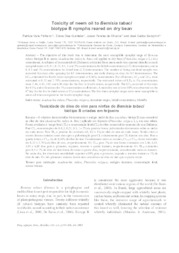Toxicity of neem oil to Bemisia tabaci biotype B nymphs reared on dry bean.
Toxicity of neem oil to Bemisia tabaci biotype B nymphs reared on dry bean.
Autoria: PINHEIRO, P. V.; QUINTELA, E. D.; OLIVEIRA, J. P. de; SERAPHIN, J. C.
Resumo: The objective of this work was to determine the most susceptible nymphal stage of Bemisia tabaci biotype B to neem (Azadirachta indica A. Juss.) oil applied to dry bean (Phaseolus vulgaris L.) in a screenhouse. A solution of commercial oil (Dalneem) extracted from neem seeds was sprayed directly on each nymphal instar at 0, 0.1, 0.25, 0.5, 1 and 2% concentrations for lethal concentration (LC) determination, and at 0, 0.5 and 1% concentrations for lethal time (LT) determination. The number of living and dead nymphs was recorded five days after spraying for LC determination, and daily during six days for LT determination. The LC50 estimated for fourth instar nymphs occurred at 0.56% concentration. For all instars, LC50 and LC95 were estimated at 0.32 and 2.78% concentrations, respectively. The estimated values of LT50 at 1% concentration were 2.46, 4.45, 3.02 and 6.98 days for the first to fourth instars, respectively. The LT50 occurred at five days for 0.5% and at four days for 1% concentration in all instars. A mortality rate of over 80% was observed on the 6th day for the first to third instars at 1% concentration. The first three nymphal stages were more susceptible to neem oil when compared to the fourth nymphal stage.
Ano de publicação: 2009
Tipo de publicação: Artigo de periódico
Unidade: Embrapa Arroz e Feijão
Observações
1 - Por padrão são exibidas publicações dos últimos 20 anos. Para encontrar publicações mais antigas, configure o filtro ano de publicação, colocando o ano a partir do qual você deseja encontrar publicações. O filtro está na coluna da esquerda na busca acima.
2 - Para ler algumas publicações da Embrapa (apenas as que estão em formato ePub), é necessário ter, no celular ou computador, um desses softwares gratuitos. Sistemas Android: Google Play Livros; IOS: iBooks; Windows e Linux: software Calibre.
Acesse outras publicações
Acesse a Base de Dados da Pesquisa Agropecuária (BDPA) para consultar o acervo completo das bibliotecas da Embrapa.

